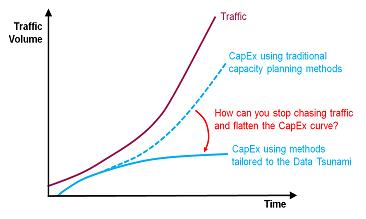A Thorn in the Side? – Handling Over-the-top Content Demands
As I interact with more and more service providers about their network capacity issues, I’ve become sure about one thing – what worked before, isn’t really working anymore. The CapEx requirement for network equipment just to keep up with the exponential growth in data traffic (i.e., Data Tsunami) is still not getting them ahead of significant congestion issues and customer impacting events. Why? Traditional capacity management paradigms are not working.
Essentially, feedback from carriers of all sizes and types has exposed one of the most significant shifts in thinking regarding how to go about managing and planning for network capacity. They know that the rules are all changing and today’s content demands are outpacing the CSPs ability to keep pace. The first key question is how to get back in front of the capacity demand (we’ll talk about monetization next…stay tuned). So, why aren’t today’s processes scaling?
- CSPs use a multitude of human resources and manual processes to manage network capacity. This may have scaled under slower and more predictable capacity growth curves, but thanks to services like You-Tube & Netflix, entire network capacity is shifting in quantum leaps.
- Solutions provided by equipment vendors are often platform specific, and reinforce a silo approach to Capacity Management when a holistic view is needed. Service demand congestion is a network phenomenon which doesn’t care about individual equipment vendors or devices.
- CSP planning groups leverage data and make decisions based on systems which have 20 – 40% inaccuracy in comparison to the actual capacity availability in the network.
- Today’s CSP solution approach is often homegrown where 90% of the time is spent on acquiring and understanding raw data. As a whole, everyone is trying to answer the question of how to proactively eliminate the possibility of congestion, but most are still focused on addressing the symptoms and not preventing the problem
It is surprising to note that even top tier/technology leaders cannot accurately predict where and when capacity issues will impact their networks. This lack of visibility hurts CSPs considerably because as per our own studies, network events are behind can account for up to 50% of customer churn in high value mobile data services.

The message from CXO’s is crystal clear – there is an urgent and dire need to find new ways of monetizing the data crossing their networks. This need is exacerbated with OTT content and net-neutrality. SLA and authentication based revenue models are absolutely dependent on knowing what types of content/services are traversing your network, how much capacity they consume, and how utilization is driven by your consumer’s interests and activities. This type of analysis requires a critical and intelligent binding of network and services data with business data to truly assess the financial impact to the CSP. Many Business Intelligence (BI) solution leaders will lay claim to abilities here, but actually fall very short of the mark. Instead, real experience suggests that solutions in the marketplace today either:
- Can handle the financial aspects of your business but have no understanding of today’s network dynamics in terms of capacity issues and services;
- Can handle parts of your network very deeply, but do not correlate or provide a holistic view at the service level; or,
- Can collect some network and service level information, but have no ability to incorporate business data to understand the impact to the business – i.e,. cost, subscriber behavior, propensities
All the above challenges bring us to the inevitable question – what kind of approach does one take in order to tackle capacity management issues? How does one stop chasing traffic and focus on flattening the CapEx curve instead? In order to attain ‘Capacity Management Nirvana‘, a proactive and scalable approach needs to be adopted by CSPs. An approach which not only intelligently binds network and business strategies based on the Data Tsunami realities but also brings proactive and predictive capacity management to the table. At the end of the day, a CSP should have access to all their capacity, the ability to leverage real and immediate feedback on the change in capacity as service uptake increases, and finally, the right tools and intelligence to get in front of what’s coming.
To know more about how a Capacity Management solution can help you address the above issues, download the whitepaper “Energizing Smart Growth with Network Intelligence“


